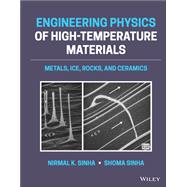Discover a comprehensive exploration of high temperature materials written by leading materials scientists
In Engineering Physics of High-Temperature Materials: Metals, Ice, Rocks, and Ceramics distinguished researchers and authors Nirmal K. Sinha and Shoma Sinha deliver a rigorous and wide-ranging discussion of the behavior of different materials at high temperatures. The book discusses a variety of physical phenomena, from plate tectonics and polar sea ice to ice-age and intraglacial depression and the postglacial rebound of Earth’s crust, stress relaxation at high temperatures, and microstructure and crack-enhanced Elasto Delayed Elastic Viscous (EDEV) models. At a very high level, Engineering Physics of High-Temperature Materials (EPHTM) takes a multidisciplinary view of the behavior of materials at temperatures close to their melting point. The volume particularly focuses on a powerful model called the Elasto-Delayed-Elastic-Viscous (EDEV) model that can be used to study a variety of inorganic materials ranging from snow and ice, metals, including complex gas-turbine engine materials, as well as natural rocks and earth formations (tectonic processes). It demonstrates how knowledge gained in one field of study can have a strong impact on other fields.
Engineering Physics of High-Temperature Materials will be of interest to a broad range of specialists, including earth scientists, volcanologists, cryospheric and interdisciplinary climate scientists, and solid-earth geophysicists. The book demonstrates that apparently dissimilar polycrystalline materials, including metals, alloys, ice, rocks, ceramics, and glassy materials, all behave in a surprisingly similar way at high temperatures. This similarity makes the information contained in the book valuable to all manner of physical scientists.
Readers will also benefit from the inclusion of:
- A thorough introduction to the importance of a unified model of high temperature material behavior, including high temperature deformation and the strength of materials
- An exploration of the nature of crystalline substances for engineering applications, including basic materials classification, solid state materials, and general physical principles
- Discussions of forensic physical materialogy and test techniques and test systems
- Examinations of creep fundamentals, including rheology and rheological terminology, and phenomenological creep failure models
Perfect for materials scientists, metallurgists, and glaciologists, Engineering Physics of High-Temperature Materials: Metals, Ice, Rocks, and Ceramics will also earn a place in the libraries of specialists in the nuclear, chemical, and aerospace industries with an interest in the physics and engineering of high-temperature materials.









